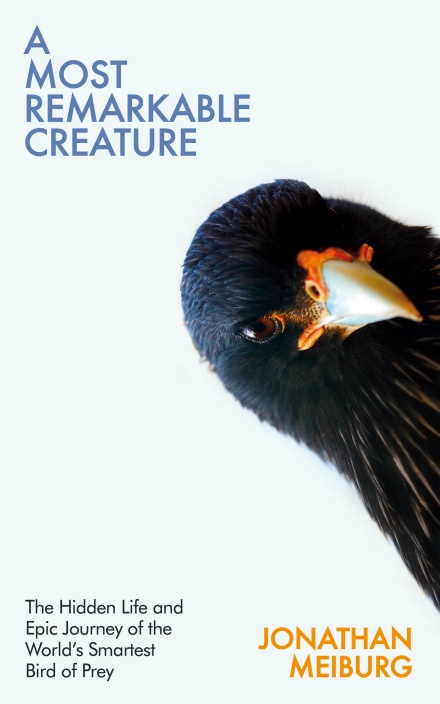Chronicling his pursuit of a little-known bird of prey — the caracara — Jonathan Meiburg’s ‘A Most Remarkable Creature’ is our Book of the Month for April. Will Burns reviews.

There have been numerous occasions on which I have been witness, over the past however many years it is now, to the impossibility of defining what exactly Caught by the River is. Is it a fishing blog, is it a nature writing journal, a festival stage, a record label, a publishing house? ‘A vision and a daydream’ still seems like a pretty good description to me. Of course this slipperiness is absolutely, and properly, part of the charm. But it struck me, reading Jonathan Meiburg’s wonderful book about an equally wonderful little group of birds, that this could almost be the definitive Caught by the River text. Meiburg has exactly the right backstory: a career making smart, literate music released on one of the undisputedly great labels of American independent rock, Sub Pop, followed by a second-act academic life predicated on a love of birds and the outdoors, resulting in the study of the species on which his book is nominally devoted — the striated caracara. As well as all this, through the course of his book, we come to know Meiburg as a fisherman, as a lover of literature, as a winning combination of curious adventurer and somebody intensely sensitive to the cultures and people of the places into which he travels. Perhaps the only moment his credentials come into question is when he turns down a beer in the last village before a long trip up river far from the conveniences of human settlement. But his tone in the telling of that one moment is suitably rueful — it truly feels like the one that got away. His book takes us from the Falklands — where his striated caracaras, or johnny rooks as they are colloquially known, first endear themselves to him with their intelligence, curiosity and, we are told, a most un-raptorlike sociability and personality — across the UK and to the deep wildernesses of Central and South America.
Meiburg’s writing possesses that rare, and very readable, ability to tread surely between the studious and the conversational that renders his obvious deep knowledge pleasingly lightly-worn. His prose voice is authoritative on the birds themselves and on the scholarly spectre of Darwin — and more importantly, William Henry Hudson, the Victorian naturalist whose work and life is a fascinating and very human strand to the book — but it’s also, crucially, a voice that never speaks down, and that relishes its own uncertainty; especially in the exceptional middle section of the book, which pulls us along on a field trip down the Rewa river in Guyana looking for red-throated caracaras with three Amerindian men and another scientist, where Meiburg has no compunction in describing his discomfort around certain snake species, huge spiders and army ants, as well as his wonder at the seemingly endless marvels that they encounter along the river.
It is this easy style that makes the book such a success, that allows Meiburg to take us as far as he does, both geographically and conceptually — we’re told, for instance, about the nature and history of caracara taxonomy, explaining how different species of raptors fit into patterns of evolution, and how that might explain some of the uncharacteristic caracara behaviour. In the telling, Meiburg deftly introduces and explains both the broad ideas at play in evolutionary science and the history of species and species interaction across the whole globe from the time of the dinosaur extinction. A huge task, one might think, and yet Meiburg pulls it off with a kind of casual confidence. The feeling one is left with is of having spent a rather wonderful evening in the company of someone both extremely knowledgable and at ease with that knowledge — the scope of his interests and experiences seem to permeate the writing; the choice of anecdote, the cast of characters, the breadth of life Meiburg is able to conure and control. Contemporary scientists, eager postgraduates, eccentric bird park owners in the English countryside, legendary figures from history and mythology, tapir, caiman, piranha, an assorted cast of South American river monsters and birds by the bucketload are all here and all clearly, vitally drawn.
We are left, then, with a book about far more than one species, or genus. A book full of deep time as well as human history. And there is something profound about knowledge with the kind of boundlessness that Meiburg aims for here — as he himself writes of William Henry Hudson, there is something to be wary of when expertise and interests become ‘closed spheres’; far better for the ‘imagination and curiosity’ to carry us beyond what Hudson calls ‘the curse of books’. Meiburg describes a ‘reverence for the unknown’ that might allow us to take in ideas that seem at first to be at odds, or somehow unrelated — rationalistic science and mystic traditions, for example, or an ability to be awed by a line of poetry in the same way as the grace of a wild creature. This is a different way of knowing, the book finally seems to suggest, and perhaps a way of knowing destined to forever be unfulfilled, to be ‘cherished, not outgrown’, and all the more valuable, and strange for that. In his penultimate chapter, Meiburg posits a possible future for his beloved johnny rook that holds within it that complexity of thought that ultimately mirrors the complexity of life: the optimistic thought that this is a species — despite evolving in one of the most isolated marginal environments on earth — that could surely thrive in that most intensely human, and at first glance apparently oppositional habitat, the city.
*
‘A Most Remarkable Creature’ is published next week by Bodley Head. Order a copy here.
Read an extract from the book here.